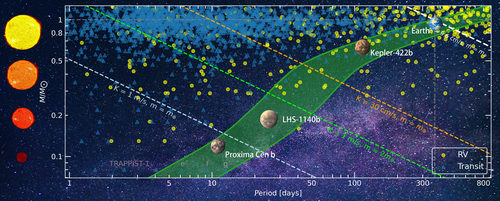The discovery and characterization of Earth-like exoplanets around main sequence stars are among the most exciting challenges in astronomy today. More specifically, an Earth-mass planet at 1AU orbital around the Sun can produce ~9.6cm/s amplitude for Doppler radial velocity measurement. How to achieve this ultimate precision is still an open question.
The latest study, published in Astronomy & Astrophysics on Jan. 2021, reveals effective methods and new models to improve the RV precision to achieve cm/s level by using the High Accuracy Radial Velocity Planet Searcher (HARPS) spectrograph.
"In this work, we apply an Astro-Comb on HARPS to investigate the radial velocity (RV) precision," said Dr. Fei Zhao from National Astronomical Observatories of Chinese Academy of Sciences (NAOC), who is the lead author of this study. “Based on the new models of RV noise we build for the first time, we have improved the wavelength calibration precision for 2 to 6 times better than before depending on different S/N levels.”
This improvement can enhance the HARPS’ RV precision at cm/s level especially for long-term detection, which is required for detecting Exo-Earth in the habitable zone.
Astro-Comb is the ideal wavelength calibrator that can produce thousands of uniformly spaced lines within the wavelength domain covered by a modern cross-dispersed astronomical spectrograph. The line frequencies can be locked to an atomic clock, from which they inherit their stability at long time scales.

Figure: The exoplanets distribution and the Doppler measurement precision. The green area is the habitable zone around the host stars. The 4 dashed lines are different RV precision level depending on various planet masses. (Image by Fei Zhao)
Recent studies show that the main uncertainty of RV precision lies in the errors in two main aspects. The first one is the wavelength calibration of the spectra. The other is the measurement of the accurate shape for spectral line profile. By analysing the Astro-Comb data on HARPS, the researchers demonstrate the new models of RV precision based on the function of the line position and line intensities. These new models can correct and re-calibrate the spectra. They can also mitigate the noisy effects and RV uncertainties. This work can reduce the RV precision to a level consistent with photon noise at a few cm/s, which is required for the detection of Earth-like exoplanets.
These new RV precision models can be widely used in high-resolution spectrographs with simultaneous calibration setups such as the 2.16m telescope with HRS spectrograph and a similar Astro-Comb at Xinglong Station, NAOC.
"Higher precision RV measurements play a significant role to discover potentially habitable worlds," said Prof. Gang Zhao who is the co-authors of this study. The future of exoplanet science is depended on the precision that can ultimately be achieved with Doppler measurements. With Astro-Comb as the calibration source, more science cases can be studied in the future such as confirming and characterizing exoplanets from transit missions and providing mass measurements for space-based missions.
This work was a collaboration between the CAS Key Laboratory of Optical Astronomy, NAOC, and the European Southern Observatory (ESO), the Instituto de Astrofísica de Canarias (IAC) in Spain, Max-Planck-Institut für Quantenoptik in Germany, and Universidade Federal do Rio Grande do Norte in Brazil.
This paper can be accessed at https://www.aanda.org/articles/aa/full_html/2021/01/aa37370-19/aa37370-19.html

Address: 20A Datun Road, Chaoyang District, Beijing, China code: 100012
Tel: 010-64888708 E-mail: naoc@nao.cas.cn

